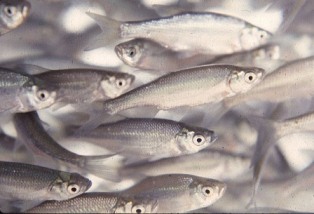Aquaculture as a Teaching Tool
David Cline, Extension Aquaculture Specialist, Auburn University
Aquaculture, like agriculture, is a complex subject with numerous facets for study in educational programs.

School teacher seeing a baby catfish still in the egg (photo courtesy of Auburn University)
A number of university, secondary agriculture, and science teachers have realized this and integrated aquaculture into their curricula. Aquaculture is an excellent teaching tool because it easily integrates many disciplines including biology, chemistry, economics, math, and physics. Growing fish, aquatic plants, and other living things in the classroom creates a living laboratory and promotes daily hands-on experiences that enrich the learning environment. It makes learning practical, experimental, and enjoyable for teachers and students.
This area of the Freshwater Aquaculture CoP is dedicated to educators. Educators are continually looking for new resources and different, more effective ways to present information. This area will assist in the location and identification of resources that can be used in teaching aquaculture and other related aquatic sciences. Resources include lesson plans, curricula evaluations, activities, access to resources, teaching materials, suppliers, and new methods.
Constructing Simple and Inexpensive Recirculating Aquaculture System (RAS) for Classroom Use
Aquaculture Lesson Plans
The National Council for Agricultural Education has produced an aquaculture curriculum that contain five original modules and 15 species-specific modules. A list of topics covered in these modules is available at: ALEARN
Aquaculture Curriculum websites
Bryant High School, Irvington, AL Aquaculture Curriculum
